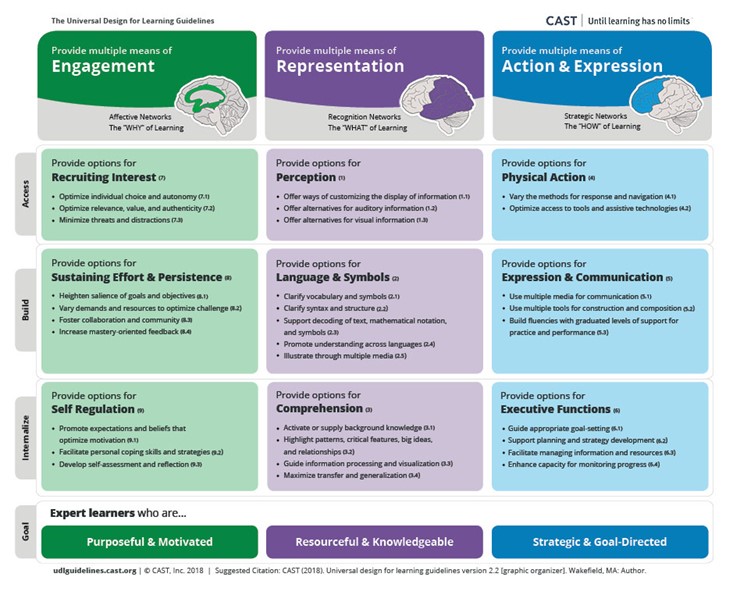6 Universal Design for Learning and Culturally Responsive Teaching
Universal Design for Learning
A powerful model for meeting the needs of each individual student, “Universal Design for Learning (UDL) is a framework to improve and optimize teaching and learning for all people based on scientific insights into how humans learn” (CAST, 2021).
UDL is structured around three main areas:
- Affective Networks: The Why of Learning or Engagement
- Recognition Networks: The What of Learning or Representation
- Strategic Networks: The How of Learning or Action & Expression
(CAST, 2020)
Explore the graphic to learn specific strategies you can use to apply UDL to your instruction. Click the graphic to zoom in.

Universal Design for Learning and Culturally Responsive Teaching
How do Universal Design for Learning and Culturally Responsive Teaching connect? According to Kieran & Anderson (2018), “both USL and CRT encourage teaching to proactively consider educational approaches that should result in increased student engagement and learning.
Open each item in the accordian to learn more about the connections between UDL and CRT.
Inclusive Design
A key part of creating a culturally responsive learning environment is to carefully consider what materials are used. As you select course content, include a wide range of perspectives in your materials. This helps show students that multiple views are valued, encouraging them to share their viewpoints and experiences to enrich the learning community.
As you select content, consider the following prompts:
- How has the course been organized in the past? Are ideas or groups excluded or distorted?
- What new research could be added to address historic exclusions?
- How might the course change if new materials are added?
- What implications might changing this course have for other courses in the curriculum?
- How can new material be fully integrated into the course (rather than tacked on)?
- What teaching strategies will be needed to support the new material?
(University of Washington, 2021)
Rudine Sims Bishop’s “Mirrors, Windows, and Sliding Glass Doors”
Rudine Sims Bishop’s, Professor Emerita of Education at Ohio State University, developed the concept of “Mirrors, Windows, and Sliding Glass Doors.” This analogy is used to demonstrate the importance of students seeing themselves reflected in course materials while also having the opportunity to look into new worlds. Watch the video below for more about this idea.
Summary
The materials we use in our courses matter. Culturally responsive educators draw on students’ cultures and experiences to share and shape the curriculum.
Next, we’ll examine and reflect on our own materials.